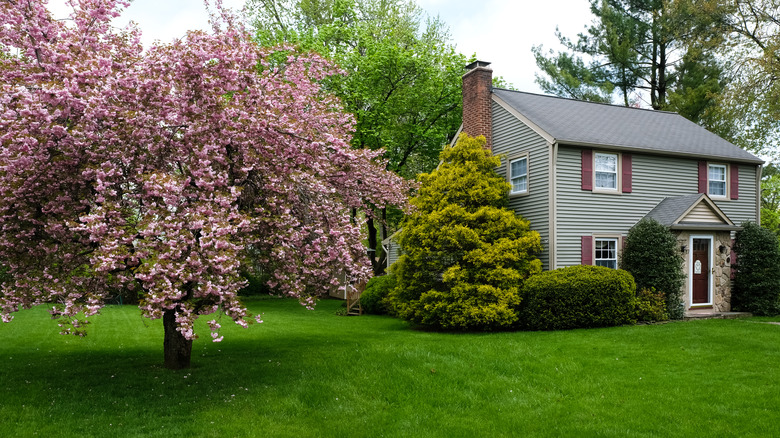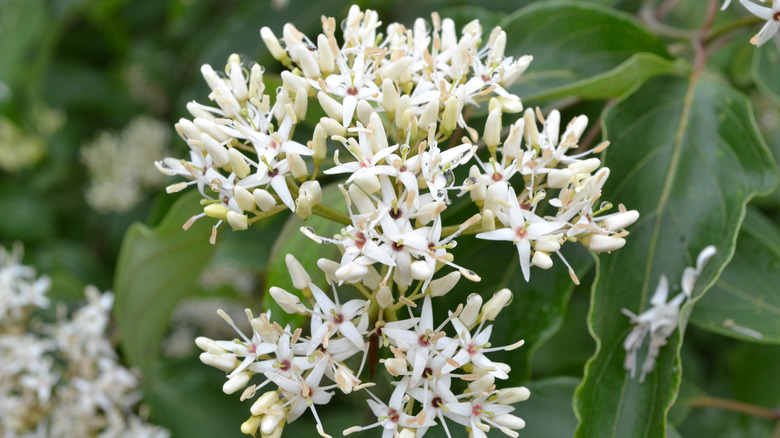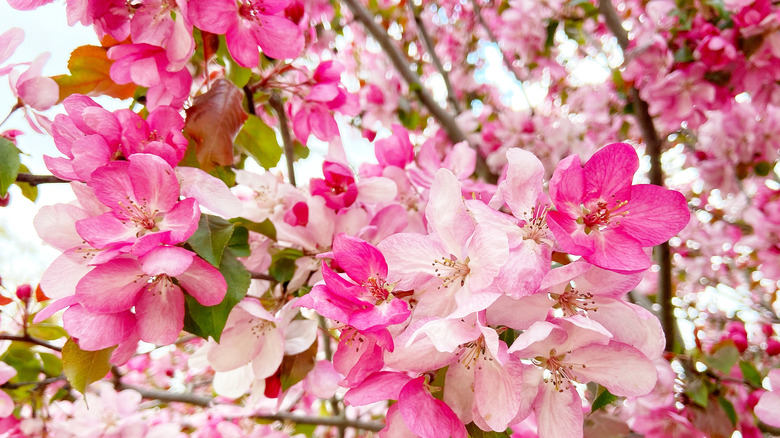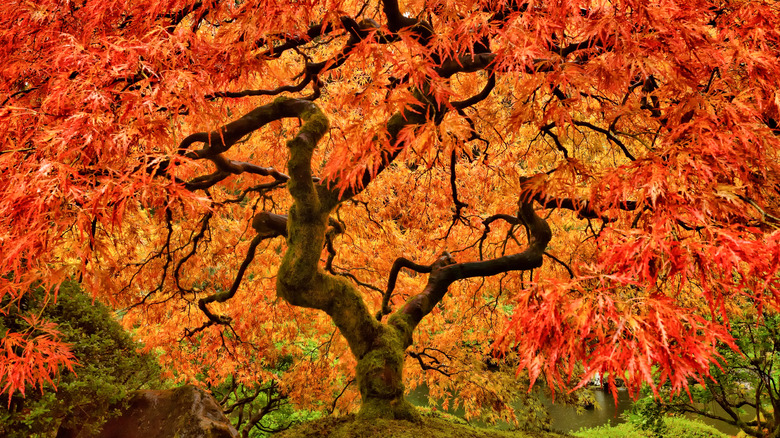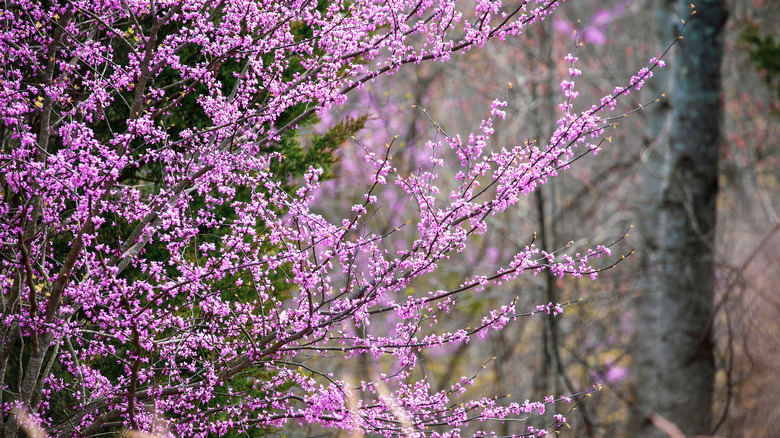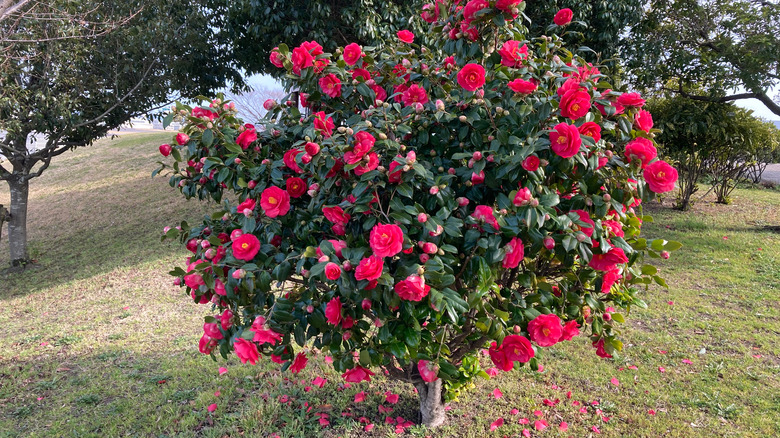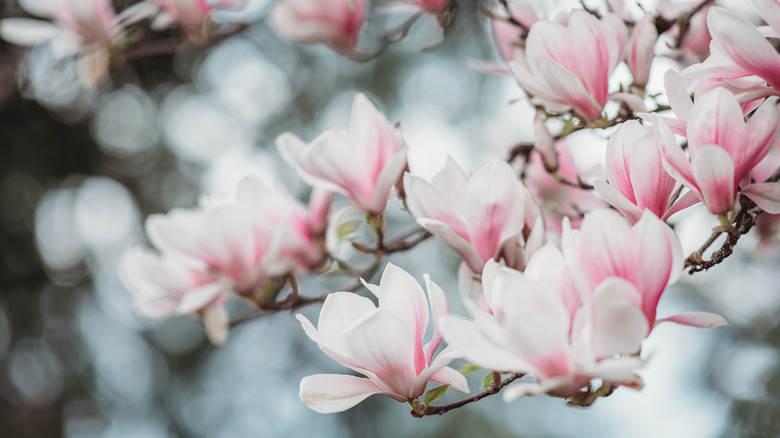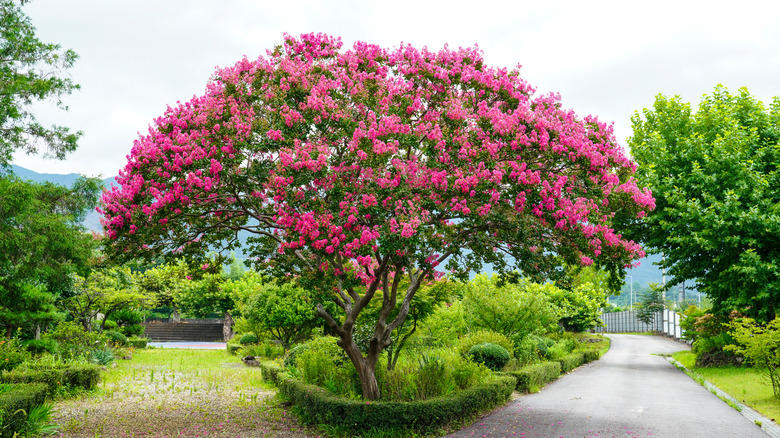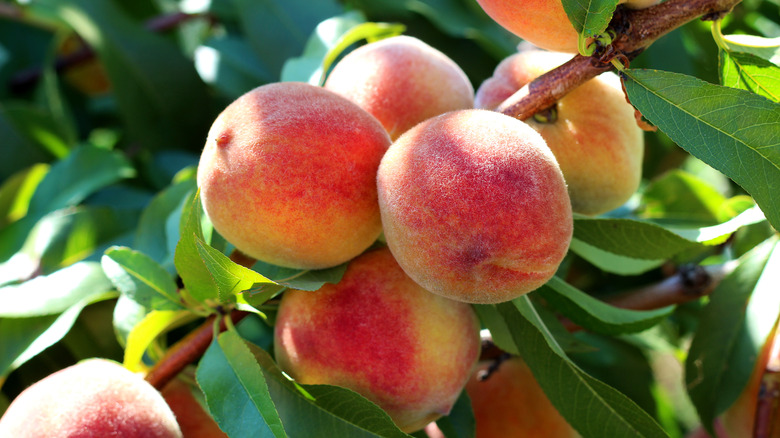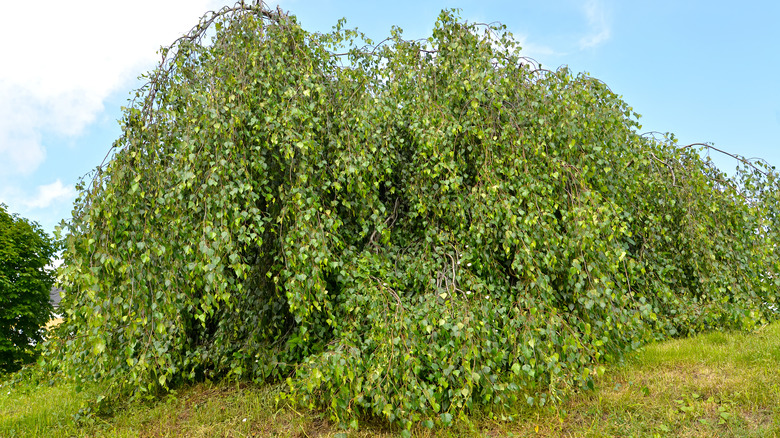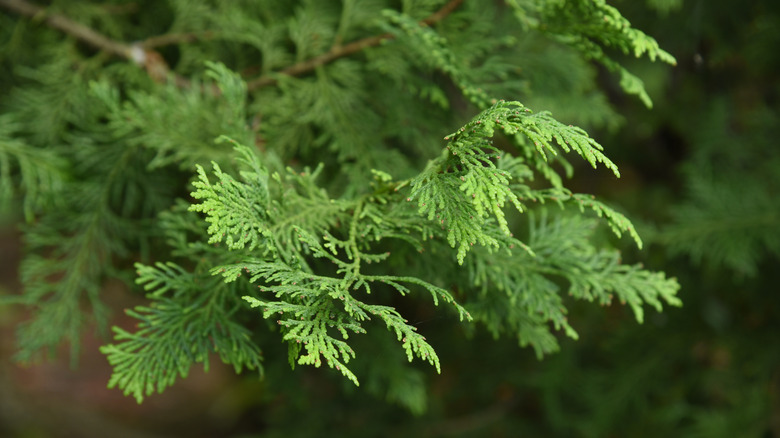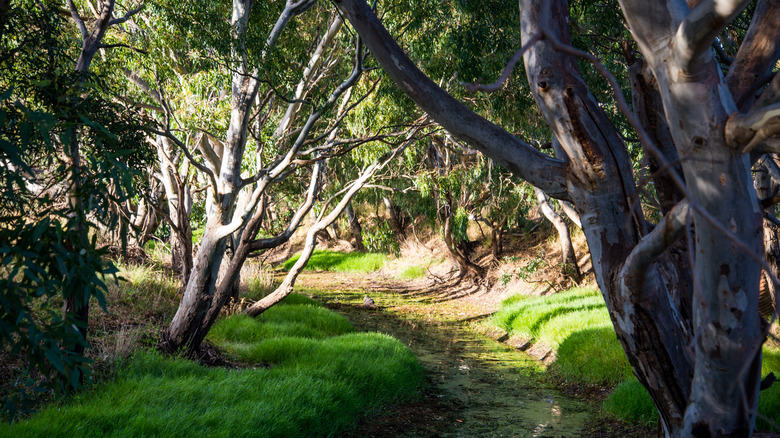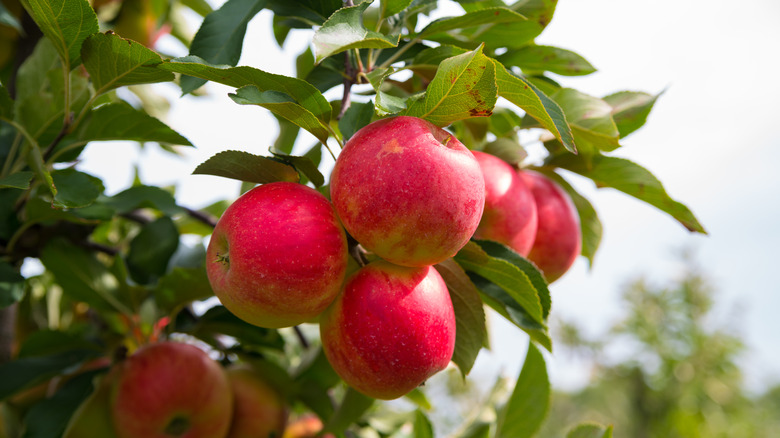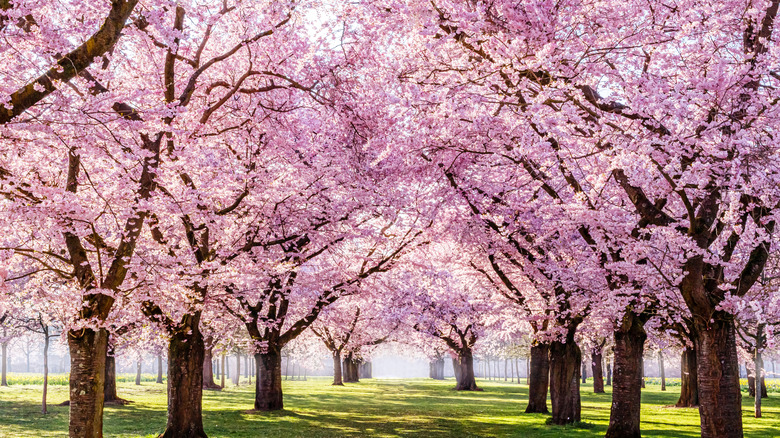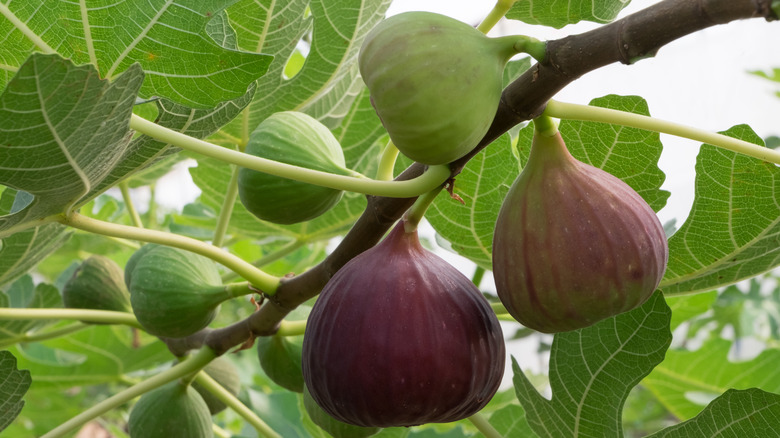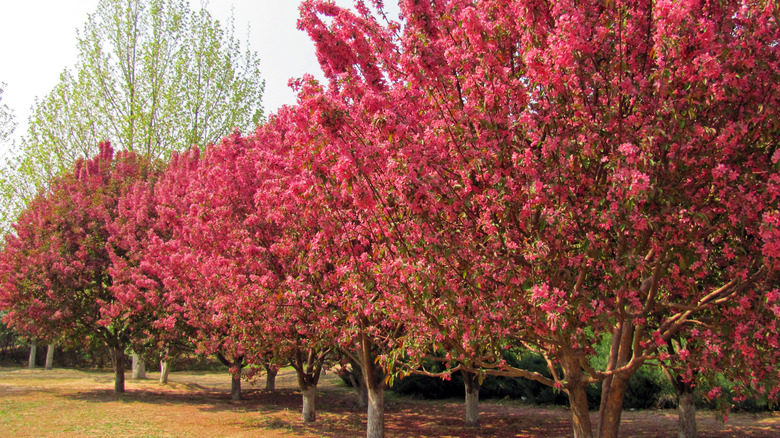15 Small Trees That Won't Overtake Your Yard
Having mature trees on your property offers a number of benefits, from cleaner air to energy conservation to attracting beneficial wildlife (via Tree People). Not all properties, however, have room to plant full-sized trees, which is where these small and dwarf varieties come in.
If you're unsure what size trees your yard can handle, consider the following formula. Kate Karam, a landscape architect with Monrovia, told Good Housekeeping that "A good rule is to plant a tree away from the house at a distance equal to one-half of the maximum tree height," adding, "For a 20-foot tree [at maturity], plant no less than 10 feet from the house. Tree roots can grow beyond the canopy of a tree, so a bit of wiggle room is a very good idea."
Before choosing a small tree for your yard, consider your USDA hardiness zone, the type of soil on your property, and the amount of sunlight the area receives.
1. Flowering Dogwood
Flowering Dogwood (Cornus florida) is native to North America, and produces spring flowers as well as bright red fruit in the fall that attracts birds to the area. It thrives in shady conditions, making it a perfect choice for those whose yards don't get a ton of natural sunlight. It also doesn't require much water, so it can survive in arid climates.
According to the University of Illinois, it's important to be mindful of the problems which can affect flowering dogwood. Some of these potential issues include the leaf disease spot anthracnose, the fungal disease dogwood anthracnod, powdery mildew, dogwood borer, and cankers.
USDA Growing Zone: 5 to 9
Sunlight needs: part-shade, shade
Soil Type: rich, well-drained, medium-loamy
Size: up to 12 to 36 feet
2. Prairifire Crabapple
Prairifire crabapple (Malus Prairifire) features flowers that are reddish-purple or maroon in the springtime, with green leaves that have reddish-purple veins during the summer months, and that turn a deep orange-yellow in the fall, according to the Arbor Day Foundation. They add that Dr. Daniel Dayton of the University of Illinois introduced the tree in the 1980s, with the intention that it become a disease-resistant cultivar. You may have noticed that Prairifire is misspelled, and it turns out that Dayton did it on purpose! Prairifire crabapple trees can thrive in a number of different conditions with a variety of soil types, and are resistant to most types of disease, making them a low-maintenance pick in many parts of the country.
USDA Growing Zone: 3 to 8
Sunlight needs: full sun
Soil Type: loamy, moist, sandy, well-drained
Size: up to 20 feet
3. Japanese Maple
Japanese maples (Acer japonicum) have long been popular because of their dramatic appearance, and their compact size which allows them to fit in small spaces. There are a number of Japanese maple varieties, all of which grow to different heights. Choose a cultivar like Waterfall, which grows to between 6 and 8 feet in height, and features green leaves in spring and summer which transform into vibrant yellow and orange hues when it autumn arrives, according to Fine Gardening.
USDA Growing Zone: 5 to 8
Sunlight needs: full sun to part shade
Soil Type: rich, moist, well-drained
Size: varies based on cultivar
4. Eastern Redbud
Eastern redbud (Cercis canadensis) is native to the United States and features pretty springtime blooms in pink, purple, or white depending on the variety. Gardenia describes it as a deciduous tree that typically has multiple trunks with branches that grow horizontally in tiers, creating a round crown. It attracts bees, hummingbirds, and butterflies, who enjoy the tree's nectar or pollen. It's important to note that redbuds don't do well when transplanted, so it's best to choose a young sapling and plant it in its permanent location.
USDA Growing Zone: 4 to 9
Sunlight needs: full sun to part sun
Soil Type: well-drained, sandy, loamy
Size: 20 to 30 feet
5. Japanese camellia
According to the North Carolina State Extenion Gardener, Japanese camellia (Camellia Japonica) originated in China, Korea, and Japan, but is now popular in the South of the United States. They add that Camellia would be a great addition to an edible garden, children's garden, or pollinator garden because it attracts both bees and songbirds. Japanese camellias require patience because they take a long time to become established. The wait pays off, however, with their long lifespans.
USDA Growing Zone: 7 to 9
Sunlight needs: partial shade
Soil Type: high in organic matter
Size: 10 to 13 feet
6. Magnolia
There are over 200 species of Magnolia (Magnolia) trees, all of which feature beautiful large flowers that come in white, pink, purple, yellow, and red shades. According to the Magnolia Society, Magnolia trees are native to tropical and subtropical regions including parts of Asia, South America, Central America, North America, and the Caribbean. Star Magnolia is a popular variety that grows to just 15 feet, making it an excellent choice for small gardens. Saucer Magnolia trees are more cold-hardy but can grow into larger trees if not pruned.
USDA Growing Zone: varies
Sunlight needs: full sun to light shade
Soil Type: moist, well-drained
Size: varies based on variety
7. Zuni Crape Myrtle
Monrovia calls the Zuni Crape Myrtle (Lagerstroemia indica x fauriei "Zuni") an excellent pick for city gardens because of its compact size. In the late summer, it produces bright pink flowers. Since it's resistant to mildew, it's a great choice for areas that become damp like entryways and patios. As soon as the soil becomes dry, it should be watered deeply. Fertilize Zuni Crape Myrtle in the spring with tree and shrub food.
USDA Growing Zone: 6 to 10
Sunlight needs: full sun
Soil Type: well-drained
Size: 9 to 12 feet
8. Peach
While most ornamental trees are relatively low-maintenance, fruit-producing trees require a little more care in order to thrive; according to HGTV, peach trees (Prunus persica) will produce delicious fruit for cooking and baking as long as they're properly pruned, fertilized, watered, and cut back each season. While standard peach trees grow to approximately 25 feet in height, dwarf varieties are available that only reach heights of six feet.
USDA Growing Zone: 5 to 9
Sunlight needs: full sun
Soil Type: well-drained, moderately fertile
Size: varies based on variety
9. Young's weeping birch
Young's weeping birch (Betula pendula "Youngii") is a dwarf variety of European white birch that only grows to a maximum of 15 feet in height, making it perfect for small yards. According to Tree Help, what sets Young's weeping birch apart is its asymmetrical branch patterns, which create a visually arresting effect that shows particularly well in a small garden. It has dark green foliage which turns yellow in the fall. To keep your Young's weeping birch healthy, fertilize it twice per year with a fertilizer that's specifically formulated for birch trees.
USDA Growing Zone: 3 to 9
Sunlight needs: full sun to light shade
Soil Type: moist, well-drained
Size: 15 feet
10. Dwarf hinoki cypress
Originating in Japan, hinoki cypress can grow up to 75 feet in height, according to The Spruce. For those with smaller outdoor spaces, however, a smaller variety known as dwarf hinoki cypress (Chamaecyparis obtusa "Nana Gracilis") is a perfect pick for lining a driveway or pathway. According to Horticulture, Dwarf hinoki cypress is an evergreen tree that maintains its deep green color all year long. Its uniquely textured foliage takes on a fanlike shape and the branches grow in a dense pattern with multiple layers.
USDA Growing Zone: 5 to 8
Sunlight needs: full sun to part shade
Soil Type: well-drained
Size: varies
11. Snow gum
Snow gum trees (Eucalyptus pauciflora) are native to Australia and range in height depending on the variety. While the word "pauciflora" actually translates to "few flowers," the name was actually a mistake based on errors made by botanists in the 1800s, according to Gardening Know How. These trees actually show beautiful white flowers in spring and the beginning of summer. It's important to note that the leaves of snow gum trees are toxic to both humans and some animals.
USDA Growing Zone: 5 to 8
Sunlight needs: full sun
Soil Type: sandy, clay, loamy
Size: 4 to 20 feet
12. Espalier apple
Unlike most trees which grow upward, Espalier apple trees (Malus pumila) are trained to grow sideways. According to an interview that gardener Ron Wade gave Fine Gardening, Espalier apple trees were first grown by the Ancient Romans, and have a long history as space-efficient, fruit-producing trees. These trees are even shorter than standard dwarf trees, growing to heights of 3 to 4 feet when they're a couple of years old. Wade says, "Even the most rambunctious of children will thrill at being asked to harvest fruit from trees no taller than they."
USDA Growing Zone: 4 to 9, per Raintree Nursery
Sunlight needs: full sun
Soil Type: unfertilized
Size: 3 to 4 feet
13. Cherry blossom
Cherry blossom trees (Prunus serrulata) have a long history in Japanese culture, with the ritual of observing their gorgeous blooms dating back as far as the 8th century, according to Brighter Blooms. Despite their name, it's important to note that cherry blossom trees don't actually produce fruit! They can also be grown in the United States, and tend to have long lifespans of between 30 and 40 years. These trees were introduced to the American public when Japan gifted the U.S. more than 3,000 cherry blossom trees which were subsequently planted in New York City and Washington, D.C.
USDA Growing Zone: varies based on variety
Sunlight needs: full sun
Soil Type: well-drained
Size: 15 to 30 feet
14. Fig
Fig trees (Ficus carica) require full sun environments and are local to northern India, the Asiatic area of Turkey, and the hotter parts of Mediterranean climates. They produce delicious fruit that ripens on the branch, as per Gardening Know How. In the U.S., fig trees can only survive outdoors year-round in USDA hardiness zones 8 through 10, but gardeners living in colder climates can plant them in containers and bring them indoors before the first frost hits in the fall.
USDA Growing Zone: 8 to 10
Sunlight needs: full sun
Soil Type: loamy, fertile, well-drained
Size: 15 to 30 feet, says Clemson University
15. 'John Downie' crabapple
"John Downie" crabapple trees (Malus Hybrida) produce tiny fruit that's about the same size as a cherry, as noted by Backyard Gardener. They act as beautiful ornamentals for small gardens because of the white flowers they produce each spring. This species is susceptible to fire blight, which can be avoided if gardeners don't over-prune or over-fertilize the trees. They can also attract aphids, which is why it's important to keep the area around the tree properly weeded.
USDA Growing Zone: 4 to 8
Sunlight needs: full sun
Soil Type: some sand or clay
Size: 15 to 25 feet
